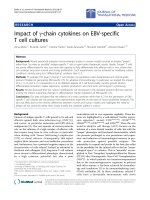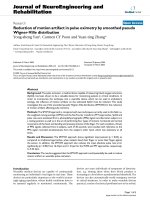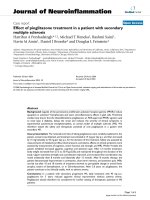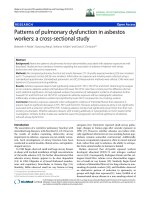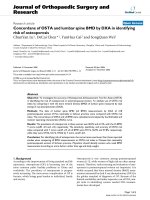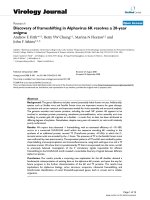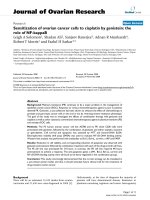Báo cáo hóa học: " Synthesis of long group IV semiconductor nanowires by molecular beam epitaxy" doc
Bạn đang xem bản rút gọn của tài liệu. Xem và tải ngay bản đầy đủ của tài liệu tại đây (689.43 KB, 7 trang )
NANO EXPRESS Open Access
Synthesis of long group IV semiconductor
nanowires by molecular beam epitaxy
Tao Xu
1
, Julien Sulerzycki
1
, Jean Philippe Nys
1
, Gilles Patriarche
2
, Bruno Grandidier
1*
, Didier Stiévenard
1
Abstract
We report the growth of Si and Ge nanowires (NWs) on a Si(111) surface by molecular beam epitaxy. While Si NWs
grow perpendicular to the surface, two types of growth axes are found for the Ge NWs. Structural studies of both
types of NWs performed with electron microscopies reveal a marked difference between the roughnesses of their
respective sidewalls. As the investigation of their length dependence on their diameter indicates that the growth
of the NWs predominantly proceeds through the diffusion of adatoms from the subst rate up along the sidewalls,
difference in the sidewall roughness qualitatively explains the length variation measured between both types of
NWs. The formation of atomically flat {111} sidewalls on the <110>-oriented Ge NWs accounts for a larger diffusion
length.
Introduction
Semiconductor nanowires (NWs) consist of a solid rod
with a diameter usually smaller than 100 nm and a
length that can vary from the nanometer to the milli-
meter-scale depending on the technique used to synthe-
size the rods. Although, for the majority of the NWs,
their growth is described by the vapor-liquid-so lid
mechanism, based on the catalytic effect of a metal seed
particle, their length is mostly related to the way the
chemical compou nds are supplied. In chemical vapor
deposition (CVD), a wide range of partial p ressures for
the reactive source gases can be used. As a result, Si
NWs with a millimeter-scale length have been success-
fully synthesized with a reasonable time [1]. Conversely,
when elemental compounds are supplie d instead of gas
precursors,asitisthecaseforthegrowthofNWsin
molecular beam epitaxy (MBE), ultra high vacuum
(UHV) conditions are required. The pressure in the sys-
temisaround10
-9
times smaller than in a CVD cham-
ber and the NW length typically does not exceed a few
micrometers [2,3].
As illustrated in Figure 1 for the MBE growth, the
ratio between the exposed surface of a seed particle and
the collection area between the seed particles is usually
small. Due to the low pressure in the growth chamber,
the direct impingement of elemental compounds onto
the seed particle has a small probability to occur. There-
fore, growth predominantly proceeds from the diffusion
of elemental compounds that adso rb on the substrate
between the seed particles. The adatoms reach the seed
particles after diffusing onthesubstrateandtheside-
walls with different diffusion length coefficients, l
S
and
l
f
, respectively. As surface diffusion is a rather slow pro-
cess, it is only because the crystallization at the interface
between the seed particlesandtheNWishighenough
that NWs emerge from the film growth. Such mass
transport mechanism yields a NW length that is inver-
sely proportional to the NW diameter [3,4].
In contrast to MBE g rown III-V semicondu ctor NWs
that can reach micrometer-scale lengths, group IV semi-
conductor NWs, which are generally grown with a
<111> orientation, show a much smaller length [ 4,5],
making their integration into devic es more difficult. In a
purpose to understand the physical mechanisms that
prevent the fabrication of group IV semiconductor NWs
with micrometer-scale lengths, we investigated the
growth of Si and Ge NWs on a Si(111) surface with the
MBE technique. In this article, we show that not only
<111> but also <110>-oriented Ge NWs are grown on
the Si(111) surface. Surprisingly, the length of the latter
can reach a few micrometers. From a comparative study
of differences in the structural morphology between
* Correspondence:
1
Département ISEN, Institut d’Electronique, de Microélectronique et de
Nanotechnologie, IEMN (CNRS, UMR 8520), 41 bd Vauban, 59046 Lille Cedex,
France
Full list of author information is available at the end of the article
Xu et al. Nanoscale Research Letters 2011, 6:113
/>© 2011 Xu et al; licensee Springer. This is an Open Access article distributed und er the terms of the Creative Commons Attribution
License ( /lic enses/by/2.0), which permits unrestricted use, distribution, and reproduction in any medium,
provided the origin al work is properly cited.
<111> and <110>-oriented NWs, we are able to explain
why <110>-oriented NWs grow longer.
Experimental details
The SiNWs were fabricated by the MBE method using
gold droplets. The gold droplets were formed directly by
gold deposition on a heated Si(111) surface in UHV at a
gold deposition pressure of 6 × 10
-10
mbar. The density
and the diameter of the gold droplets are determined by
the Au evaporation rate and the temperature of the
samples via the Ostwald ripening process [6]. In the
next step, the growth of the NWs was achieved from
the sublimation of Si or Ge at a deposition pressure of
10
-9
mbar. In order to grow th e NWs, the Si(111) sur-
face was heated either at 550°C for the growth of Si
NWs or at 350°C to obtain Ge NWs. The evaporation
rate of elemental Si and Ge was measured from the
thickness of the two-dimensional film grown on the
substrate during the NW growth.
The morphology of the NWs was investigated by elec-
tron mic rosc opies: scanning electron microscope (SEM)
and high-resolution transmission electron microscope
(HRTEM). To perform the HRTEM experiments, the
NWs were cleaved with micromanipulators in the
chamber equipped with a focus ion beam machine and
transfer into holey grids covered with a very thin carbon
layer.
Results and discussion
Tilted views of the post-growth Si(111) surfaces are
shown i n Figure 2. When Si is sublimated, the majority
of the Si NWS are found to be perpendicular to the Si
(111) surface (Figure 2a). Their growth axis is thus
along the [111] direction, in agreement with previous
observations [4,5]. In cont rast, the growth of Ge NWs
leads to two different kinds of growth directions
(Figure 2b). The shortest NWs usually show the Au
seed particle just above the overgrown Ge film. These
NWs appear normal to the surface when observed in
top view SEM images such as the one shown in the
inset of Figure 3. They thus grow along the [111] direc-
tion, likewise the Si NWs. As for the second type of Ge
NWs,theseNWsaremuchlongerandpointat54.7°
from the surface plane. In the top view SEM image of
Figure 3, these inclined Ge NWs are found to grow
along three different directions only. When projected in
the (111) surface plane, the directions make an angle of
60°. Therefore, these Ge NWs are oriented along one of
the equivalent <110> directions, in agreement with the
Figure 1 Model of group IV semiconductor NW growth by
MBE. The NW has a length L and a diameter D. Elemental
compounds are evaporated with a rate J and impinge on the
surface as well as on the Au seed particle, positioned at the top of
the NW. Once adsorbed, the adatoms diffuse on the substrate and
on the NW sidewalls with diffusion lengths l
s
and l
f
, respectively.
Au adatoms can also diffuse away from the seed particle.
Figure 2 SEM images of (a) Si NWs and (b) Ge NWs grown
on a Si(111) surface by MBE. The orientations of the NWs are
indicated in the SEM images. The growth times were 2 and 1 h for
the Si and Ge NWs, respectively. The scale bars correspond to
400 nm.
Xu et al. Nanoscale Research Letters 2011, 6:113
/>Page 2 of 7
growth of <110>-oriented Ge NWs obtained on the Ge
(111) surface by MBE [7].
Group IV semiconductors NWs have been found to
grow with different orientations, depending on the tem-
perature of the surface during the growth and the eva-
poration rate of elemen tal Si or Ge. While a high surface
temperature favors t he growth of <111>-oriented NWs,
contradictory results have been obtained regarding the
effect of t he evaporation rate [7,8]. However, consistent
with these previous studies, we note that the comparison
of the length between the <111>-oriented Ge NW and
those oriented along th e <110> directions shows a strong
difference. In our study, the first types of NWs are rarely
higher than the overgrown Ge layer, while for the second
type of NWs, the part of the NWs that surpasses the
overgrown Ge layer can reach a length of 2 μmwhenthe
growth time is 60 min and the deposition rate is about
1.7 Å/s. The growth direction of the NWs thus seems to
play an important role on the maximum le ngth that
group IV semiconductor NWs can reach. Although the
deposition rate of Si was 0.5 Å/s in Figure 2a, a two-hour
growth does not allow to build NWs higher than 400 nm,
consistent with previous results that reported the difficul-
ties to grow <111>-oriente d Si NWs longer than 500 nm
by MBE [9].
In order to u nderstand the physical origin of the
growth direction dependence on the NW length, we
examined the sidewalls of both types of NWs, as shown
in Figure 4. The <111>-oriented Si NWs consist of six
sidewalls that exhibit small f acets. It has been shown
that these sidewalls correspond to {112} planes [9]. For
<111>-oriented Si NWs grown by CVD at low silane
partial pressure, that show similar sidewall orientations
[10], gold is known to diffuse from the seed particle and
to wet the sidewalls [11,12]. Adsorption of gold on Si
(112) planes is also known to causes the faceting of
these planes [13]. Similarly, Au diffusion from the seed
particle is at the origin of the facet formation on the
{112} planes, for which the crystallographic orientations
alternate between {111} planes and high index planes
[14]. HRTEM images of the sidewalls for the MBE
grown Si NWs are consistent with the observat ions per-
formed on <111>-oriented Si NWs grown by CVD. For
example, Figure 4a2 reveals the rough morphology of
one of the {112} sidewalls. Although the facets are rather
rounded, probably due to the oxide layer that covered
the sidewall, a corrugation of up to 2 nm is found when
the height profile of the sidewall is measured.
As for the <110>-oriented Ge NWs, they also exhibit
an irregular hexagonal cross-section, but the orienta-
tions of the sidewalls are different. They consist of {111}
and {100} planes, where two {100} planes are opposite
to each other and are separated on each side by two
adjacent {111} planes [15,16]. In addition, the {100}
planes are usually narrower than the {111 } planes and
their width decreases toward the base of the NWs,
which undergoes the longest exposure time to the Ge
deposition and diffusion (Figure 4b1). As the {111}
planes are the dominant sidewalls, these sidewalls were
investigated by HRTEM. Figure 4b 2 shows that the
{111} sidewalls are atomically flat. Scattered bright clus-
ters are also seen superimposed to the atomic lattice
and indicate the presence of Au-rich clusters.
Similarly t o the <111>-oriented Si NWs, gold diffuses
from the seed particle to wet the sidewalls of the <110>-
oriented Ge NWs. However, in contrast to the adsorp-
tion of gold on the {112} planes, the adsorption of gold
on the Si and Ge (111) surfaces does not produce a
roughening of the surface. Instead, atomically flat (111)
surfaces are generally observed with a √3×√3 recon-
struction, when the Au coverage is higher than one
monolayer [17-19]. Our observation of a flat sidewall is
thus consistent with previous surface studies about the
adsorption of gold on group IV semiconductor (111)
surfaces. In addition, as the {111} sidewalls contain Au-
rich clusters, we might expect to have more than one
monolayer of gold adsorbed on the NW sidewalls. Such
result suggests that the formation of a √3×√3recon-
struction between the clusters occurs during the NW
growth in UHV.
As already described in the introduction, the growth
of NWs by MBE predominantly proceeds through the
diffusion of adatoms that adsorb on the substrate in
between the NWs. Indee d, if we consider the surface of
the seed particle exposed to t he flux of elemental com-
pounds and the area surrounding the NWs that serves
as a reservoir to collect adatoms for the NW growth,
Figure 3 Top view SEM images of Ge NWs grown on a Si(111)
that show the different growth direction. The scale bars
correspond to 100 nm.
Xu et al. Nanoscale Research Letters 2011, 6:113
/>Page 3 of 7
their ratio is usually quite small. When the NW is still
short, typically at the beginning of the growth, the con-
tribution of the adatoms diffusing from the substrate up
along the NW is thus the strongest to the g rowth rate.
This mechanism implies that the crystallization rate at
the interface between the seed particle and the N W is
related to the flow of diffusing adatoms that become
incorporated when they reach the circumference of the
interface [4]. It yields a char acteristic signature: the NW
length varies like the inverse of the diameter. Such a
behavior appears in Figure 5a for the case of the <111>-
oriented Si NWs grown by MBE.
It is also visible after a 15 min for the growth of
<110>-oriented Ge NWs (Figure 5b). Although the
Figure 4 SEM observation of NW sidewalls for (a1) a <111>-orie nted Si NWs and (b1) a <110>-oriented Ge NWs grown on a Si(111)
surface by MBE. Some sidewall orientations are indicated for both types of NWs. Lattice-resolved TEM images showing the roughness of (a2) a
{112} sidewall on a <111>-oriented Si NWs and (b2) a {111} sidewall on a <110>-oriented Ge NWs.
Xu et al. Nanoscale Research Letters 2011, 6:113
/>Page 4 of 7
deposition rate was almost similar, comparison of the
maximum length that can be reached between the
<111> and <110>-oriented NWs clearly shows that the
<110>-oriented NWs are quickly much longer. Based on
the mass transport model described in [20], in the case
of NWs that are still short, the length growth rate
dependence on the adatoms diffu sing onto the sidewal ls
from the substrate towa rd the interface between the Au
droplet and the NW is expressed as follows:
dL
dt
J
DL
4
cosh /
f
(1)
where Ω, J, and l
f
are, respectively, the atomic volume
of the growth species, the flow of adatoms from the sub-
strate toward the NW sidewalls, and the diffusion length
along the NW sidewalls. Considering that Ω and J do
not significantly vary between the growth of Si a nd Ge
NWs, for a given diameter, the length growth rate is
found to vary as the inverse of a cosh function that
depends on l
f
. A higher diffusion length on the side-
walls results in an increase of the length growth rate.
Surface diffusion requires overcoming an energy barrier
[21]. The smaller the surface corrugation is, the lower the
activation energy is. For a given time, elemental Si or Ge
can thus diffuse fur ther away from their adsorption site
Figure 5 Correlation between the length and the diameter of <111>-oriented Si NWs and <110>-ori ented Ge NWs.ForGeNWs,the
data are measured for two different growth times. The evaporation rate for both experiments was 1.5 ± 0.2 Å/s.
Xu et al. Nanoscale Research Letters 2011, 6:113
/>Page 5 of 7
when the surface is atomically flat [22]. The longest diffu-
sion length fou nd for the case of <110>-oriented Ge
NWs is, therefore, consistent with atomically flat {111}
sidewalls in comparison with the rough-facetted {112}
sidewalls of the <111>-oriented NWs.
When L becomes larger than l
f
,thenthelength
growth rate depends mainly on the diffusion of ada-
toms that adsorb directly onto the NW sidewalls or on
the seed particle. Therefore, the NWs with the sm allest
diameters grew slower while the NWs with the biggest
diameters keep on growing with the same length
growth rate. The effect of a limited diffusion length is
readily visible in Figure 6. While the <110>-oriented
Ge NWs appear cylindrical at the beginning of the
growth (Figure 6a), some of the {111} sidewalls may
show a change of their morphology, as the growth pro-
ceeds. Such an example is seen in Figure 6b, where a
strong overgrowth occurs at the base of the NW indi-
cating that the adatoms from the substrate are rather
incorporated onto the sidewalls than diffusing up to
the top of the NWs. Finally, when the growth duration
approaches tens of minutes, Au may have completely
diffused away from the original seed particle. As a
result, the NW cannot grow in length a ny more, but
overgrowth on the sidewalls occurs. The {100} side-
walls, for which the surface tension is higher [15,23],
disappear through the lateral growth of the {111}
sidewalls, giving rise to a typicalrhombohedralcross-
section (Figure 6c).
In summary, by combining SEM and TEM analysis of
group IV semiconductor NWs grown by MBE on a Si
(111) surface, the stru ctural properties of Si and Ge
NWs with different growth axes have been inves tigated.
As gold diffuses from the seed particle during the
growth and wets the NW sidewalls, a significant change
of the sidewall roughness can occur depending on the
sidewall orientations. The roughness strongly affects the
diffusion length of the diffusing Si or Ge adatoms
toward the interface between the seed particle and the
NW, and prevents the growt h of NWs with micro-
meter-scale lengths. A good control of the NW growth
axis is, therefore, important to obtain sidewalls with the
lowest surface tension.
Abbreviations
CVD: chemical vapor deposition; HRTEM: high-resolution transmission
electron microscope; MBE: molecular beam epitaxy; NWs: nanowires; SEM:
scanning electron microscope; UHV: ultra high vacuum.
Acknowledgements
We thank D. Troadec for the manipulation of the Ge NWs onto the TEM
grid. The authors acknowledge financial support from the DGA (Direction
Générale de l’Armement) under contract REI-N02008.34.0031.
Author details
1
Département ISEN, Institut d’Electronique, de Microélectronique et de
Nanotechnologie, IEMN (CNRS, UMR 8520), 41 bd Vauban, 59046 Lille Cedex,
Figure 6 Evolution of the <110>-oriented Ge NW morphology. The NWs initially show (a) an irregular hexagonal cross-section , then (b) a
reduction of the gold seed particle and a lateral overgrowth on the {111} sidewall that is exposed to the Ge flux, and finally (c) the
disappearance of both the gold seed particle and the {100} sidewalls, giving rise to Ge NW with a rhombohedral cross-section.
Xu et al. Nanoscale Research Letters 2011, 6:113
/>Page 6 of 7
France
2
CNRS-Laboratoire de Photonique et de Nanostructures, Route de
Nozay, 91460 Marcoussis, France
Authors’ contributions
TX, JPN, BG designed the experiments, TX,JS,JPN performed the experiments,
GP performed the TEM analyses, BG wrote the paper. All authors discussed
the results and commented on the manuscript.
Competing interests
The authors declare that they have no competing interests.
Received: 20 September 2010 Accepted: 2 February 2011
Published: 2 February 2011
References
1. Park W II, Zheng G, Jiang X, Tian B, Lieber CM: Controlled synthesis of
millimeter-long silicon nanowires with uniform electronic properties.
Nano Lett 2008, 8:3004.
2. Plante MC, LaPierre RR: Growth mechanisms of GaAs nanowires by gas
source molecular beam epitaxy. J Cryst Growth 2006, 286:394.
3. Dubrovskii VG, Cirlin GE, Soshnikov IP, Tonkikh AA, Sibirev NV,
Samsonenko YB, Ustinov YB: Diffusion-induced growth of GaAs
nanowhiskers during molecular beam epitaxy: Theory and experiment.
Phys Rev B 2005, 71:205325.
4. Schubert L, Werner P, Zakharov ND, Gerth G, Kolb FM, Long L, Gösele U,
Tan TY: Silicon nanowhiskers grown on (111) Si substrates by molecular-
beam epitaxy. Appl Phys Lett 2004, 84:4968.
5. Dujardin R, Poydenot V, Devillers T, Favre-Nicolin V, Gentile P, Barski A:
Growth mechanism of Si nanowhiskers and SiGe heterostructures in Si
nanowhiskers: X-ray scattering and electron microscopy investigations.
Appl Phys Lett 2006, 89:153129.
6. Xu T, Nys JP, Grandidier B, Stiévenard D, Coffinier Y, Boukherroub R,
Larde R, Cadel E, Pareige P: Growth of Si nanowires on micropillars for
the study of their dopant distribution by atom probe tomography. J Vac
Sci Technol B 2008, 26:1960.
7. Kramer A, Albrecht M, Boeck T, Remmele T, Schramm P, Fornari R: Self-
assembled and ordered growth of silicon and germanium nanowires.
Superlatt Microsctruct 2009, 46:277.
8. Irrera A, Pecora EF, Priolo F: Control of growth mechanisms and
orientation in epitaxial Si nanowires grown by electron beam
evaporation. Nanotechnology 2009, 20:135601.
9. Werner P, Zakharov ND, Gerth G, Schubert L, Gösele U: On the formation
of Si nanowires by molecular beam epitaxy. Int J Mater Res 2006, 97:1008.
10. Ross FM, Tersoff J, Reuter MC: Sawtooth Faceting in Silicon Nanowires.
Phys Rev Lett 2005, 95:146104.
11. Hannon JB, Kodambaka S, Ross F, Tromp RM: The influence of the surface
migration of gold on the growth of silicon nanowires. Nature 2006,
440:69.
12. Den Hertog M, Rouvière JL, Dhalluin F, Desré PJ, Gentile P, Ferret P,
Oehler F, Baron T: Control of gold surface diffusion on Si nanowires.
Nano Lett 2008, 8:1544.
13. Wiethoff C, Ross FM, Copel M, Horn-von Hoegen M, Meyer zu Heringdorf F-
J: Au Stabilization and Coverage of Sawtooth Facets on Si Nanowires
Grown by Vapor- Liquid- Solid Epitaxy. Nano Lett 2008, 8:3065.
14. Xu T, Nys JP, Addad A, Lebedev OI, Urbieta A, Salhi B, Berthe M,
Grandidier B, Stiévenard D: Faceted sidewalls of silicon nanowires: Au-
induced structural reconstructions and electronic properties. Phys Rev B
2010, 81:115403.
15. Wu Y, Cui Y, Huynh L, Barrelet CJ, Bell DC, Lieber CM: Controlled growth
and structures of molecular-scale silicon nanowires. Nano Lett 2004,
4:433.
16. Hanrath T, Korgel BA: Crystallography and surface faceting of germanium
nanowires. Small 2005, 1:717.
17. Nagao T, Hasegawa S, Tsuchie K, Ino S, Voges C, Klos G, Pfnür H, Henzler M:
Structural phase transitions of Si (111)-(√3×√3) R30°-Au: Phase
transitions in domain-wall configurations. Phys Rev B 1998, 57:10100.
18. Grozea D, Bengu E, Marks LD: Surface phase diagrams for the Ag-Ge (111)
and Au-Si (111) systems. Surf Sci 2000, 461:23.
19. Seehofer L, Johnson RL: STM study of gold on Ge (111). Surf Sci 1994,
318:21.
20. Johansson J, Svensson CPT, Mårtensson T, Samuelson L, Seifert W: Mass
transport model for semiconductor nanowire growth. J Chem Phys 2005,
109:13567.
21. Gomer R: Diffusion of adsorbates on metal surfaces. Rep Prog Phys 1990,
53:917.
22. Mo YW, Lagally MG: Anisotropy in surface migration of Si and Ge on Si
(001). Surf Sci 1991, 248:313.
23. Zhang JM, Ma F, Xu KW, Xin XT: Anisotropy analysis of the surface energy
of diamond cubic crystals. Surf Interface Anal 2003, 35:805.
doi:10.1186/1556-276X-6-113
Cite this article as: Xu et al.: Synthes is of long group IV semiconductor
nanowires by molecular beam epitaxy. Nanoscale Research Letters 2011
6:113.
Submit your manuscript to a
journal and benefi t from:
7 Convenient online submission
7 Rigorous peer review
7 Immediate publication on acceptance
7 Open access: articles freely available online
7 High visibility within the fi eld
7 Retaining the copyright to your article
Submit your next manuscript at 7 springeropen.com
Xu et al. Nanoscale Research Letters 2011, 6:113
/>Page 7 of 7
